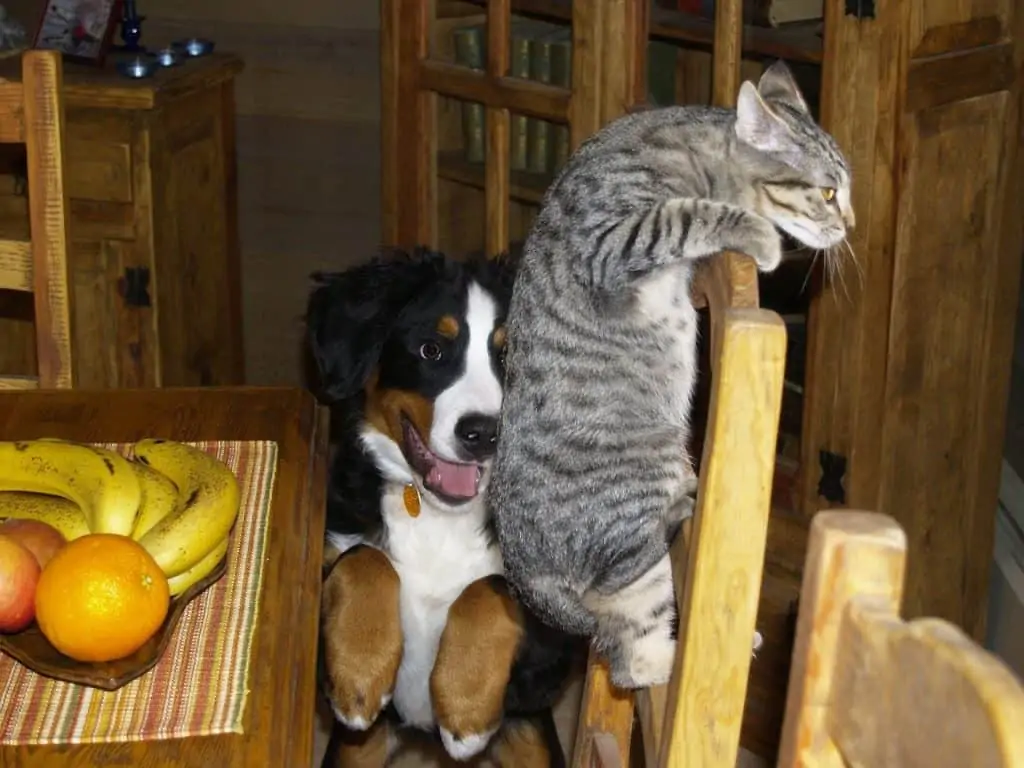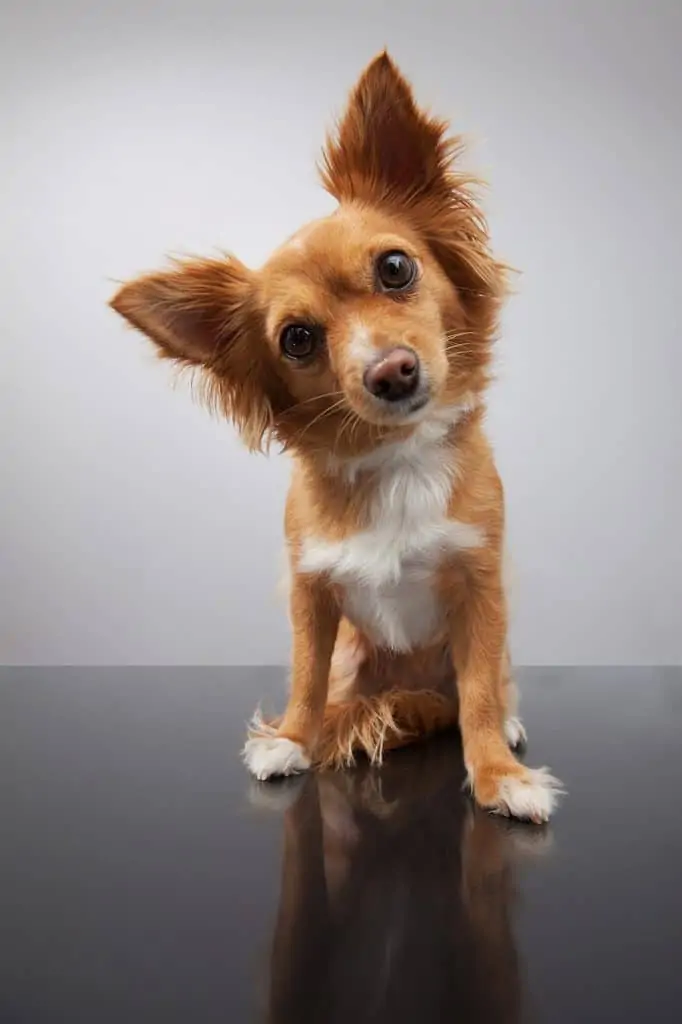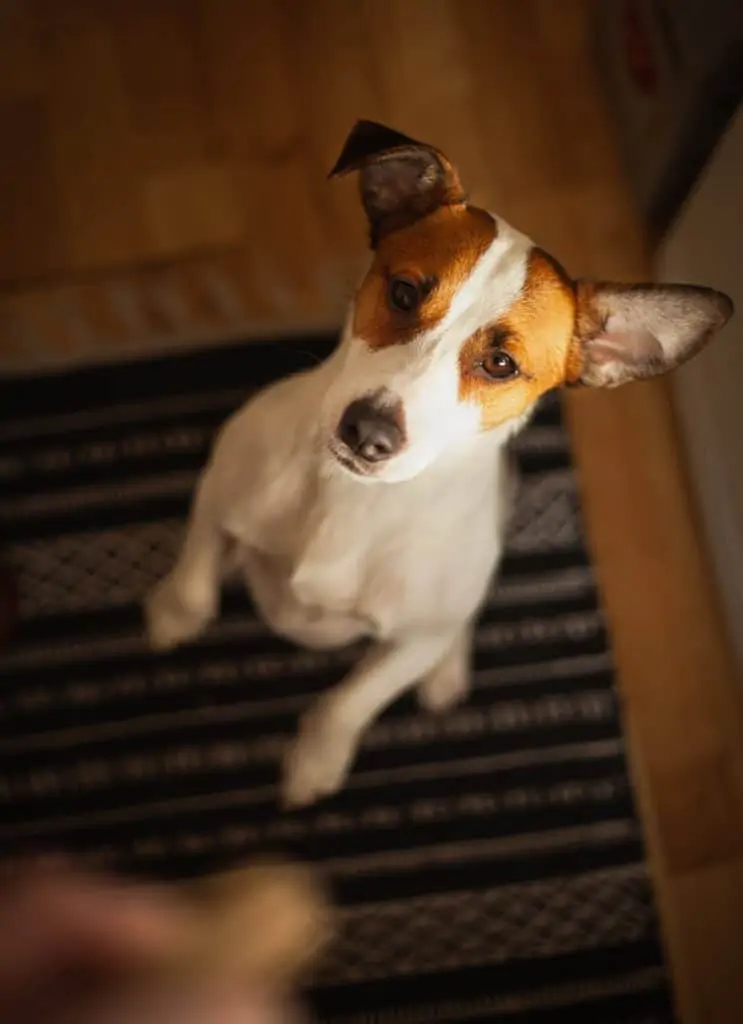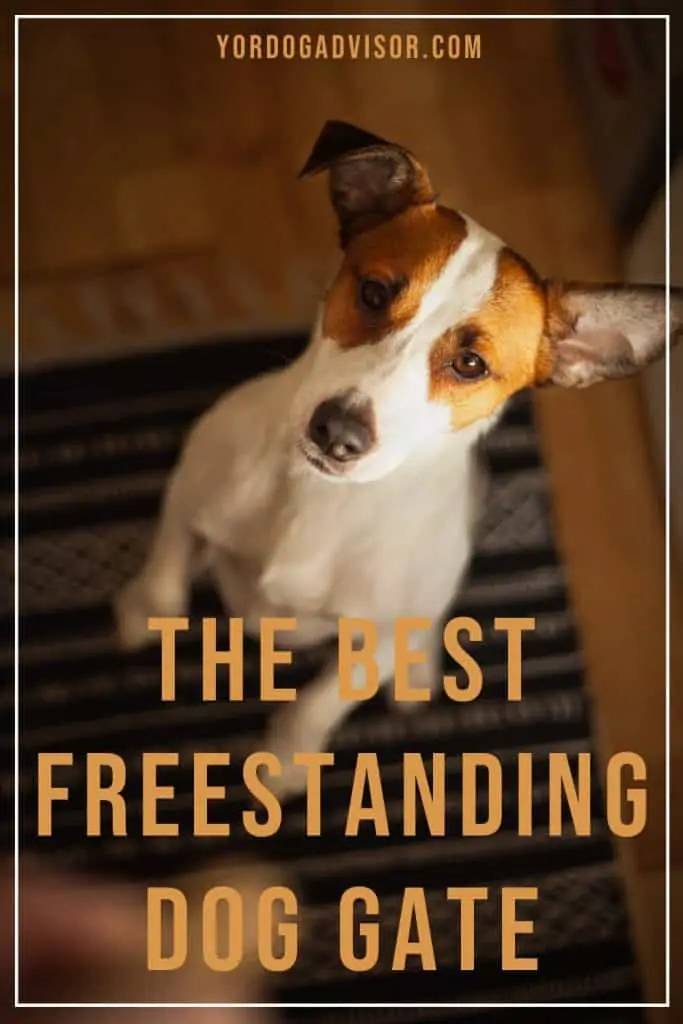Anyone with a dog already knows that puppy-proofing your home goes far beyond puppyhood. Though dogs age, most of them tend to hold onto their puppy-like curiosity. This is both charming and concerning, as this curiosity can sometimes get them into trouble.
Luckily, there are a few ways you can go about protecting your dog from himself by ensuring you keep him out of spaces in your home he shouldn’t be.
And this is where a freestanding pet gate can come in handy.
But do freestanding pet gates really work? More importantly, are they safe to set up in your home?
That’s what we’re here to find out. Join us as we learn more about freestanding pet gates, their pros and cons, and help you find the best gate option for your dog.
Contents
What Is A Freestanding Pet Gate?
A freestanding dog gate can help keep your dog safe by keeping him out of rooms he shouldn’t be in.
A freestanding pet gate is pretty much what it sounds like – it’s a gate that does not require hardware or installation and stands on its own. Pet gates have a number of purposes, but freestanding pet gates are specifically designed to be easily set up or taken down at a moments’ notice.
This is ideal for those with smaller spaces or who travel often and need a pet gate that is easy to store or travel with.
Free standing pet gate options are also wonderful dividers to help separate larger pets from smaller pets or to keep dogs and cats apart.
Do you need a freestanding pet gate? Let’s find out.
Why Would A Freestanding Pet Gate Be Necessary?
Pet gates help keep pets off of tables, out of garbage, and may even keep them away from dangerous or hazardous areas.
A freestanding pet gate may not be right for your specific home and dog. However, many pet parents find that a freestanding pet gate is the perfect alternative to gates that require installation.
But is a gate at all really necessary for a dog? You may be the ideal candidate for a freestanding pet gate if:
You Have Small Dogs
Freestanding pet gates are ideal for smaller dogs and puppies because they are less likely to tip them over. Most small dogs and puppies can do just fine with freestanding pet gates.
You Are Puppy Training
Puppy training is the ideal time for you to consider investing in a freestanding pet gate or puppy playpen. But a freestanding pet gate isn’t just for potty training. It can also help keep puppies from chewing on furniture during their teething stage or having access to the house while they are still learning boundaries.
Not only can a freestanding pet gate help to keep your puppy safe, it can help to teach him where his special areas are in the home.
You Are Renting Property
If you’re renting an apartment or home, you may want to consider investing in a freestanding pet gate or at least a puppy playpen or crate.
These options provide you with the ability to protect your dog without requiring you to install anything into your wall. Free standing pet gates are not only easy to use, they can also help prevent property damage if your pet suffers from anxiety or stress by keeping your dog out of areas where he may be tempted to mark or chew.
You Have Company Over With An Unsocialized Dog
If you have company over but your dog hasn’t been adequately socialized, you might consider investing in a freestanding pet gate for a couple of reasons. First, some dogs become overwhelmed with company and will enjoy having their own space behind a gate.
Furthermore, guests or children who are not used to your dog may become too handsy, and a freestanding pet gate can help send a message that your dog likes to be left alone.
You Leave Your Doors Open Often And Your Dog Is A Runner
Do you come and go often? If so, it’s a good idea to consider a freestanding pet gate. This gate can help barricade your dog safely inside your home or yard while you leave your gate or door open.
You Travel Often With Your Dog
Traveling with your dog is fun, but it can also be stressful. Introducing your dog to new environments that may not have been properly dog-proofed could be dangerous, which is why we recommend investing in a freestanding pet gate for trips.
These gates are ideal for storage, as many of them fold flat. Furthermore, they can be set up and taken down in a pinch.
Which Types of Dogs Are NOT Good Candidates For A Freestanding Pet Gate?
Freestanding pet gates may be easily toppled, so they’re not right for every pet.
Most experts agree that a freestanding pet gate is not ideal for every dog and home. In fact, they advise against investing in a freestanding pet gate if you have a large breed dog or a high energy dog.
That said, older large breed dogs or more calm large breed dogs will likely do okay with freestanding dog gates, as can dogs who are very well trained.
However, there are some instances where freestanding dog gates can cause more problems than they solve, and it’s important you consider this before investing. You should not use a freestanding pet gate if:
You Have Large Breed Or High Energy Dogs
As we just mentioned, high energy dogs and large breed dogs can easily topple a freestanding pet gate. No matter the quality or weight, if a dog gate is not properly installed into a wall, it can easily come down.
While this is one of the pros of a freestanding pet gate, it can also be problematic and defeat the purpose of successfully keeping your dog in a specific area.
You Are Leaving Your Dog Unsupervised
If you are leaving your dog unsupervised, do not rely on a freestanding dog gate to keep your dog in a specific area. Dogs behave differently once we are gone, and a dog who behaves well behind a freestanding pet gate in your presence may feel confident enough to knock the gate over when you are away.
This is especially true if you have installed a freestanding pet gate to prevent destructive behaviors or to keep your dog out of areas of your home that could be dangerous for him. If this is the case, it’s best to use gates you must install that cannot be toppiled. Or, you might consider using a dog playpen that closes securely, crate training your dog, or to putting your dog in a room where the door can close.
You Have Infants Or Toddlers In The Home
Using a freestanding pet gate in a home with infants or toddlers can be dangerous, as these gates can easily be knocked or pushed over. Many of them are heavy and can cause injury to a child if they fall or land on them.
You Are Attempting To Barricade An Aggressive Or Fearful Dog
Last, it’s not a good idea to use a freestanding pet gate to barricade a potentially aggressive or fearful dog. These gates are not sturdy enough to keep your dog or your company protected. If you have a dog that is not properly socialized, suffers from anxiety or is potentially aggressive, it’s best to properly crate train your dog or keep your dog in a separate room while company is over.
With that in mind, let’s take a look at the pros and cons of using a freestanding pet gate in your home.
Pros of A Freestanding Pet Gate
- Freestanding pet gates are easy to set up and take down
- They are inexpensive and easy to find
- Freestanding pet gates don’t require hardware, drilling or installation
- Freestanding pet gates are easy to store
- They are travel friendly
- These gates are ideal for small dogs and puppies
Cons of A Freestanding Pet Gate
- Freestanding dog gates are not ideal for large dogs or energetic dogs
- They are not 100% full-proof
- A freestanding pet gate can easily be knocked over
- Freestanding pet gates could harm children or infants
- Freestanding pet gates should not be used without supervision
The Best Freestanding Pet Gate For Dogs and Puppies
Investing in a dog gate is an important part of puppy-proofing your home.
As we briefly discussed, a freestanding pet gate is not the ideal gate for every dog. However, they can work wonders for smaller dogs, senior dogs, young puppies and very well trained dogs.
If your dog is an ideal candidate for a freestanding pet gate, then you’ll want to take a look at some of our favorite gates below.
Internet’s Best Traditional Pet Gate
No products found.
If you’re looking for a traditional and easy to install freestanding pet gate, we would recommend Internet’s Best Pet Gate above. This gate comes in two sizes depending on your needs including a 24 inch height and a 36 inch height.
This gate also comes in two colors including white and brown. The gate is made with four panels and stands depending on how you position it. As with most freestanding pet gate options, it’s important not to use this in place of a baby gate or wall mounted gate. It’s especially important that you do not use this gate above stairs.
While we like that this gate folds and travels easily for storage, it is not the ideal freestanding pet gate for those with large breed dogs, active dogs or dogs that could easily tip the gate over.
Carlson Extra Tall Freestanding Pet Gate
No products found.
A sturdier freestanding pet gate option is made by Carlson Pet Products. This freestanding pet gate is 70 inches wide and is adjustable. It also stands extra tall so it can be ideal for larger dogs who will not try and tip it over.
We do like that this freestanding gate comes with legs on either side to help prevent tipping. It is also made with non-toxic materials that are safe for pets should they decide to chew it.
The only issue we see with this freestanding pet gate is that it is made of wood and could easily be chewed by bored pets or pets with anxiety.
PetMaker Freestanding Pet Gate
No products found.
The PetMaker Freestanding Pet Gate is another simple gate we recommend using for small dogs or young puppies. This gate will be easily tipped, however, and should be used only with supervision and to keep small pets out of rooms or to teach them boundaries.
This freestanding pet gate comes in white and can include a three panel design, a four panel designed, or a scalloped design. The gate is ideal for very small dogs that could be prone to sneaking through the panel of larger pet gates, as the individual panels on this gate are only two inches wide.
As with all freestanding pet gate options on this list, this gate requires no installation. It is also simple to fold and put away to store, making it ideal for travel or company.
The Hoovy Store Decorative Freestanding Pet Gate
No products found.
For those with smaller dogs, a decorative freestanding pet gate is not only effective but adorable. Of course, these gates are not ideal for large breed dogs as they are smaller and can easily be knocked over.
Even if you do want a decorative gate, it’s important not to skimp on quality. The below freestanding pet gate is made of quality material, though it is lightweight. It comes with either paw or bone designs, or you can get it with diamond designs if you don’t want it to look specifically like a pet gate.
Hoovy Leaf Design Freestanding Pet Gate
No products found.
Another freestanding pet gate we like by Hoovy is the above foldable metal pet gate. This gate can be used for multiple purposes, but it is designed as a pet gate without looking like a pet gate.
It is made of quality metal material and is designed with unique leaf patterning that is gorgeous and functional. This pet gate is extendable, fitting up to 45 inch doorways. It also folds flat for storage.
Freestanding Pet Gate Alternatives
Larger dogs may require more sturdy or taller freestanding pet gates.
If your dog is not the ideal candidate for a freestanding pet gate, don’t worry. There are plenty of alternatives including but not limited to:
- Puppy Playpens
- Wall-Mounted Gates
- And Crates
The option that will work best for you will depend on your home and your unique dog. When using a gate, crate or playpen with your dog, it’s important to implement training to help your dog get used to the product.
It’s also best to refrain from punishment and scolding when introducing one of the above items to your dog, as this can lead him to associating the item with something negative.
If you’re not sure which type of gate or product would be right for you, we have listed some of our favorite products below that can serve as good alternatives for freestanding pet gates.
Momcozy Retractable Pet Gate
No products found.
If you’re looking for a good pet gate that works for both pets and children and will not be easily knocked over, we recommend the retractable Pet/Baby Gate by Momcozy. This gate comes in three colors to match your walls and plays the role of a removable freestanding pet gate as it is easy to use or put away.
The difference is that it is attached to the wall and can fold open or retract back in. This gate is safe enough to use for infants and sturdy enough to use with large breed dogs. It extends up to 55 inches wide and is ideal for large spaces.
Amazon Basics Foldable Playpen
No products found.
Freestanding pet gates are not ideal for all dogs, and even wall mounted pet gates don’t work for everyone. If that is the case for you, we recommend trying a foldable metal playpen. This playpen by Amazon Basics is ideal for dogs of all sizes and breeds. It is easy to set up and comes in five different sizes depending on your needs.
You can use this playpen both indoors and out to keep your dog safe and happy. It also helps prevent destructive behaviors in dogs that have separation anxiety. The pen folds flat for storage and can be ordered with or without a gated door entry.
MidWest Homes Dog Crate
No products found.
The MidWest Homes Dog Crate is one of our favorites when it comes to basic crates for dogs. When crate training is done properly, dogs often find that their crate is a safe space where they can go to relax, eat or nap.
The above dog crate is foldable for storage and comes with a single or double door for easier access. It is also available in different sizes and can include a divider for easier training if you’re working with a puppy.
Other Ways To Keep Your Dog Out Of Rooms He Shouldn’t Be in
Provide your dog with plenty to keep him busy and ensure he knows where you want him to play, instead of where you don’t want him to play.
Along with investing in the best freestanding pet gate or pet gate alternative, there are a number of other ways you can go about ensuring your dog stays out of areas he shouldn’t be in.
Remember, keeping your dog safe is a big job, and while dogs are intelligent creatures, they are also child-like when it comes to their curiosity. Our human homes are not always conducive to safely raising dogs, so it’s important to take steps to make sure your home is as safe as possible for your furry family member by following the below tips.
Set Up Boundaries Early On
It’s never too late to train your dog no matter how old he is. However, it is easier to teach your dog about boundaries early on. When you first get your dog, set up an area that is all his and make sure he knows which areas of your home are off limits.
Whether your freestanding pet gate is up or not, your dog should learn that there are spaces in your home he may not be allowed to roam.
Don’t Leave Tempting Items In Reach Like Open Garbage Bins or Food On The Table
Even if your dog knows he is not allowed in the kitchen, he may still be tempted by smelly foods either on the counter or in the trash. To help your dog follow the rules, refrain from leaving food in reach and avoid leaving stinky leftovers in the garbage bin.
Ensure Your Dog Has Plenty To Do To Keep Himself Busy And Entertained
Most dogs venture out of their “safe zone” in the home when they become bored. This is especially true if you’re not home for a few hours. To ensure your dog doesn’t commit doggy crimes by going into rooms he shouldn’t, keep him busy by providing him with puzzle toys or Kongs and activities that hold his interest.
Consider Investing In A Doggy Play Pen Or Work On Crate Training
As we mentioned above, if your dog is not the ideal candidate for a freestanding pet gate you always have the option of a crate or playpen.
Playpens are wonderful not only for puppies but also for older dogs who have a mischievous streak. A crate is ideal for dogs with anxiety, as they can help reduce stress if utilized appropriately.
When trying to consider which option would be right for your furry family member, it’s best to do some research and speak with your vet or a positive reinforcement based trainer.
Teach Your Dog What You Want Him To Do Instead of What You Don’t Want Him To Do
Last but not least, work with your dog using positive reinforcement like treats and praise to show him what you want from him instead of what you don’t want. Remember, dogs inherently want to please us. While they may know they are not allowed in the kitchen, they may not know where else to go.
Show your dog where his space is, teach him ques like “go to bed”, or “go outside”, or “go to the living room”. This will give him something to do and a place to focus his energy.
Training Your Dog To Stay Out Of Rooms – The Do’s And Don’ts
Train your dog using positive reinforcement and begin as early as you can.
A freestanding pet gate can solve a number of problems for you and your dog, but nothing works as well as quality training. When you work with your dog to ensure he knows where his boundaries are, you are not only reducing chances of behavioral issues or property damage, but also potential safety issues for your pooch.
Here are some expert tips and tricks on training your dog while also using a freestanding pet gate or pet gate alternative:
Have A Solid Recall Or Cue Word
When you’re working with your dog on training, make sure you have a solid recall or cue word that gets his attention. This will help you call your dog back if he either gets too close to a room he shouldn’t enter or if you see him going towards an open front door, for example.
Make sure you use the same word as your recall or cue word each time, and that the rest of the family knows to use it as well.
Be Consistent
Consistency is key when it comes to training. This goes along with ensuring your family is on board with training techniques, que words and schedules. This helps reduce confusion and ensures your dog understands what you want from him.
Use Positive Reinforcement Methods
Positive reinforcement has consistently been proven to work most effectively when it comes to training. This means that using treats, praise, toys and play instead of punishment, force, fear and scolding will not only hold your dog’s attention, but translate your message to him more clearly.
Don’t Leave Tempting Items Out In Your Dog’s Reach
As we previously discussed, leaving things around that your dog will be tempted to chew on or eat is basically like setting your dog up for defeat. While dogs can develop a strong sense of willpower and discipline, they are still dogs and will be driven by their instincts.
So if you leave a tasty turkey wing on the table and walk away, don’t expect your dog to ignore his instinct to snatch it!
Consider Hiring A Trainer
If your dog is especially anxious, aggressive, or suffers from other types of behavioral issues, it’s important not to rely on a gate to solve these problems alone. We recommend contacting a trainer or behaviorist to help you conquer serious behavioral issues. Not only will this reduce your chances of needing to use a freestanding pet gate, but it will also help enhance your dog’s quality of life and strengthen the bond between the two of you! And that’s worth everything.
Did you find a good dog freestanding pet gate on this list, or would you prefer to have a wall-mounted dog gate now that you know the pros and cons? Leave us your thoughts in the comment section below.
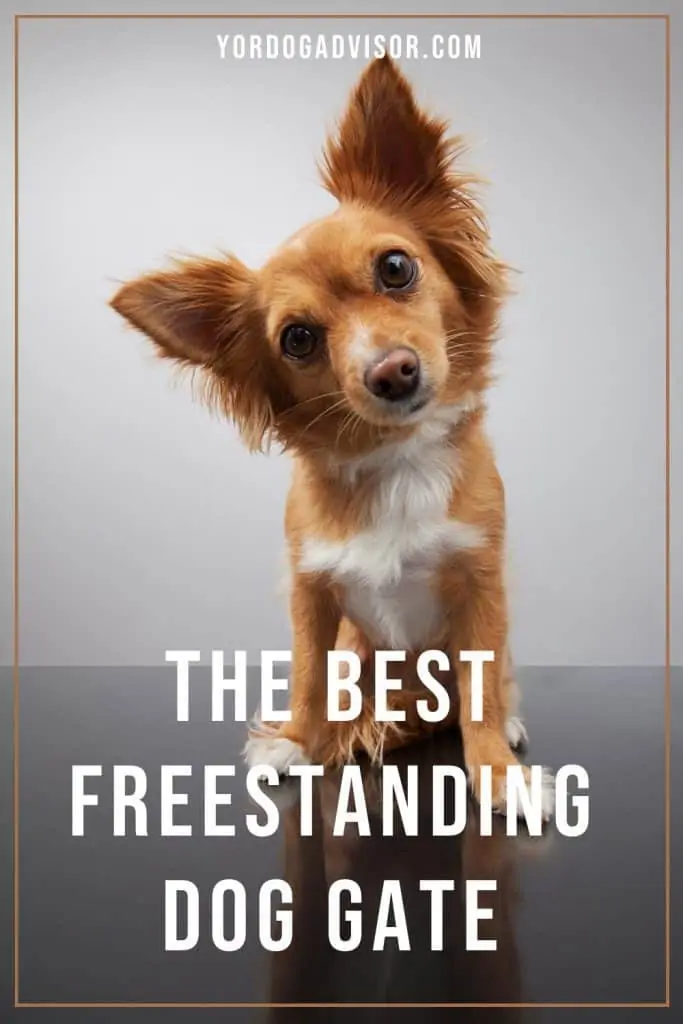

Jen Jones is a professional dog trainer and behavior specialist with more than 25 years of experience. As the founder of ‘Your Dog Advisor’ and the ‘Canine Connection’ rehabilitation center, she applies a holistic, empathetic approach, aiming to address root causes rather than merely treating symptoms.
Well known for her intuitive and compassionate approach, Jen adopts scientifically-proven, reward-based methods, encouraging positive reinforcement over punishment. Jen specializes in obedience training, behavior modification, and puppy socialization. Her innovative methods, particularly in addressing anxiety and aggression issues, have been widely recognized. Jen has worked with many of the world’s leading dog behaviorists and in her free time volunteers with local animal shelters and rescue groups.

